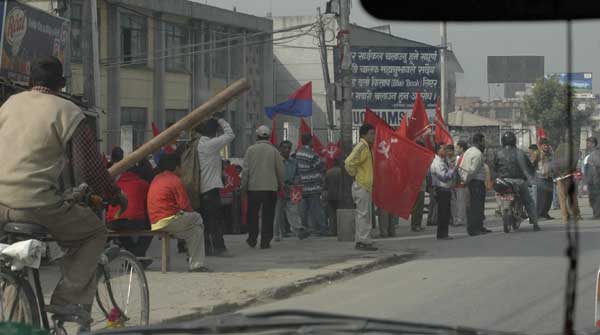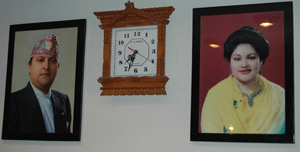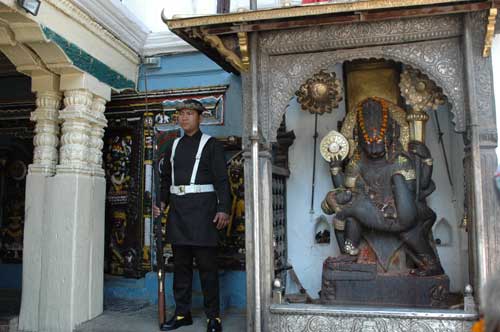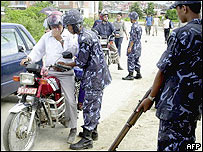SWEDISH SOUTH ASIAN STUDIES NETWORK
Kathmandu 30 November 2005
Nepal – country in political turmoil
 |
| Demonstration against King Gyanendra in Kathmandu on 2 December 2005. 50 000 people paraded the streets in a manifestation organised by Communist Party of Nepal/United Marxist-Leninist (CPN/UML). |
If Bhutan presently is characterised by a guided transition to modernity moderated by the stronghold of its royalty and traditions, Nepal, as is well known, is in a political turmoil. The latest earthquake here was in 1934. This time it is not a physical earthquake that seems imminent, but a social one. A country closed to the outside world from the mid-nineteenth to the mid-twentieth century, and then slowly awakening to the surroundings from the early 1950s onwards, now with dramatic intensity.
City under ‘siege’?
There is now a large number of political refugees in Kathmandu, who
have come from rural Nepal. In the 2001 census the city population was
given at 1.6 million, but now with the heavy inflow it may be close to
2.5 million, nobody knows for sure.
The Maoists have made large parts of rural Nepal their land, mustering
maybe around 1 lakh men and women in arms. They represent the educated
youth who knows both the physical and social terrain and they target not
just the army but also the village elite and members of political parties.
This has created a widespread feeling of insecurity and made many people
flee to Kathmandu.
 |
| Portraits of the royal couple on display on the walls in every public office in Kathmandu. |
What do they want? The message is a socialist revolution, the aim a communist
society! Surround and beleaguer the cities!
So what is in store for this country? In September 2005 the Maoists declared
a three month unilateral truce, which ended in December, the day after
we leave for Bangladesh. Are we just escaping Armageddon? Or is this a
belated bourgeois revolution in the making?
Since February 2005 King Gyanendra has taken full control over the government,
with the motivation that the political parties cannot govern the country.
Well armoured Kathmandu, the Maoists cannot take it seems. And do they
want to do it? This is not just a matter of the strength of the Nepalese
army but of the geopolitics of India and the other superpowers including
China. And behind the strategy of the Maoists there seem to be another
motive. After all, this is not the city of Havana in 1959! This is after
all a Hindu Kingdom with a strong Buddhist tradition.
 Mix
of Hinduism and Buddhism
Mix
of Hinduism and Buddhism
The impression of siege is not fuelled by what meets the eye as we enter the city on its crowded streets. This is a historical mix of Hinduism and Buddhism – and tourists – as nowhere else in South Asia. The result is a colourful and imaginative syncretism of ideas, unique to the world.
Here is Hinduism in all its rich variety, with a strong presence of nature in the form of female goddesses and Tantric rituals straddling with Nepalese and Tibetan forms of Buddhism, Vajrajana, the diamond road. Here are intricate relations between male and female and an erotic symbolism. On the surface this is nowadays an urban ‘traditional’ culture with great liberties in religion and life styles attracting all kinds of visitors and also probably reinforced by the tourist ‘eye’.
Set in natural beauty Nepal is perhaps unmatched anywhere else. Kathmandu
now has a service culture with everything a tourist can wish for, catering
to low budget travellers as well as the high class trekkers starting their
adventure in Hyatt Regency five star hotel in the city; restaurants with
world variety of foods, temples, monasteries and old architecture of world
heritage sites all around.
However, below this glittering appearance is a hierarchical and oppressive
caste and tribe society, toughened by the fact that this is today the
only nation on earth with Hinduism as state religion and a strong royal
family ruling under this ideology. 85 per cent of people are said to be
Hindus, with a caste system much the same as in India, with Brahmins at
the top and ex-untouchables at the bottom. Like in India there is a growing
Dalit movement among the latter. However, there are a great number of
tribal groups spread out throughout the country confessing to Buddhism
and other types of religion – a total of 90 languages are spoken
– and the figure of 85 % Hindus may be grossly misrepresentative.
With no colonial past, there is little wonder also that there is no nationalism
to speak of in Nepal.
Industry and services more and more important
The total population of Nepal is above 24 million. Still agriculture in the richly irrigated valleys is the mainstay of most people, but 41 % of the national income derives from service and industrial sector today, with tourism at about 3.5% to GDP (but 15% of total foreign exchange earnings). A figure, which most probable is on the decline in the current political situation.
 In
1990 there was widespread urban agitation for a democratic political system
manifested in Jan Andolan (People’s movement) which staged mass
demonstrations in Kathmandu. A representative democracy was introduced
in 1991 with a parliament of 205 seats. But the political parties, formed
much along the same lines as in India, have been unable to form strong
and effective governments.
In
1990 there was widespread urban agitation for a democratic political system
manifested in Jan Andolan (People’s movement) which staged mass
demonstrations in Kathmandu. A representative democracy was introduced
in 1991 with a parliament of 205 seats. But the political parties, formed
much along the same lines as in India, have been unable to form strong
and effective governments.
The parliament was dissolved in 1995 and new elections held the same year.
The following year the Maoists started their armed uprising, which now
seems to culminate with their control of most parts of rural Nepal.
This has, of course made government policies and implementation increasingly
difficult, though the insurgents have left most of the economic transactions
undisturbed except for tourism. From a high of about 400 000 tourist coming
per year, the figure may now be as low as 200 000 (uncertain statistics).
Again, there were fresh elections in 1999, but no effective formation
of stable governments. This is the background to the take over of the
government by the king himself in February 2005. More
about Nepal on SASNET’s special web page.
SASNET - Swedish South Asian Studies Network/Lund
University
Address: Scheelevägen 15 D, SE-223 70 Lund, Sweden
Phone: +46 46 222 73 40
Webmaster: Lars Eklund
Last updated
2006-02-13
